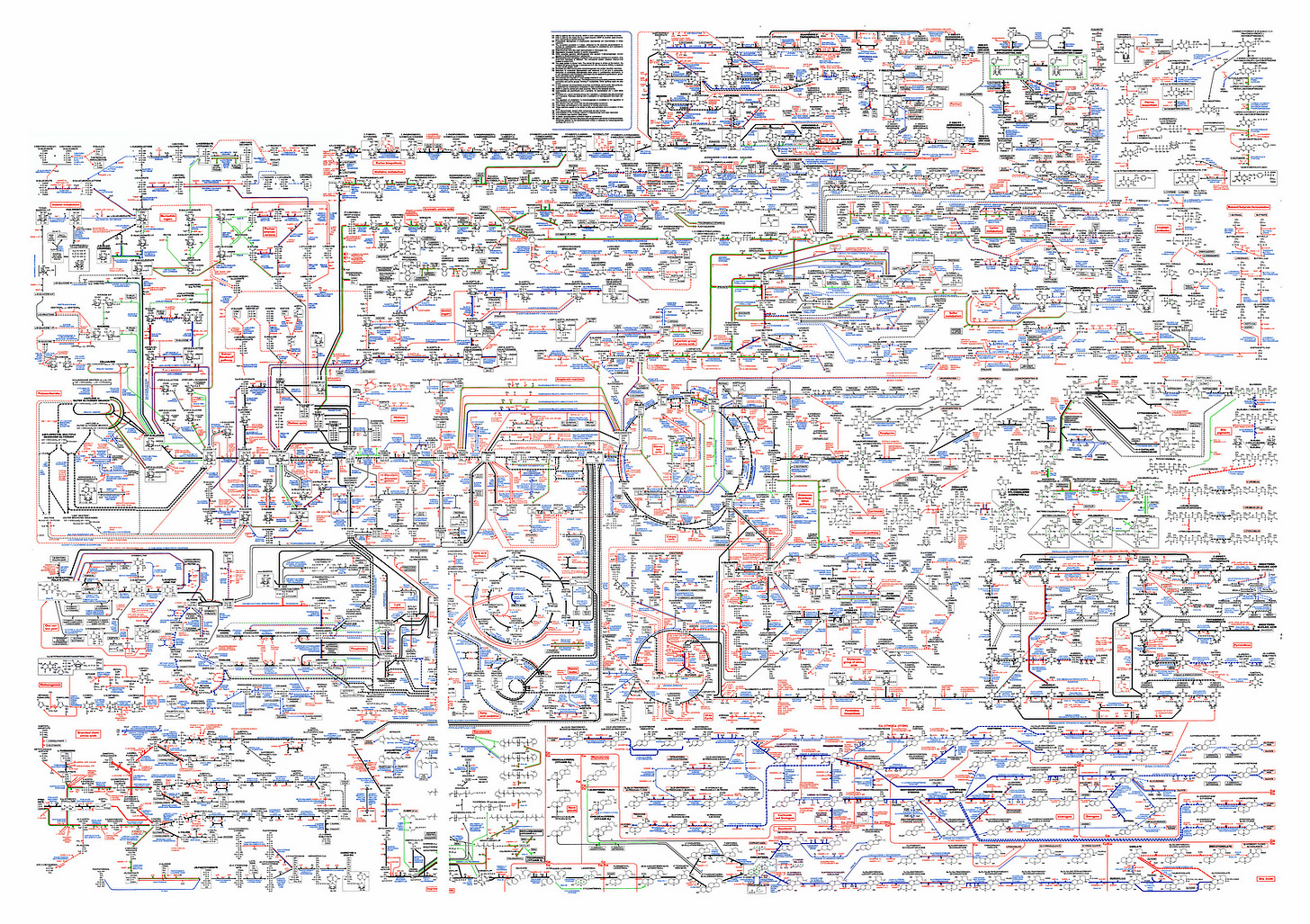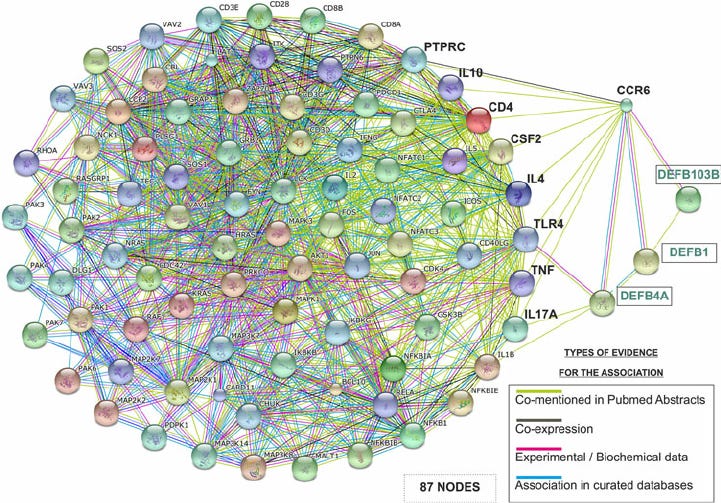How Drug Design Resembles Playing Pool Billiards
Why are Off Target Effects and Prescribing Cascades So Common?
First a disclaimer for sensitive (conventional) minds: As a Chemical Engineer and Materials Scientist (with many of my friends and Ph.D. classmates now running pharmaceutical companies), I am not against all pharmaceuticals. Most new synthetic drugs (like biohacks and supplements) try to “fix” dysfunctional cellular metabolism, for example, of lipids (fat) or glucose (sugar), by targeting and manipulating certain molecular pathways that cause metabolic dysfunction and imbalance (or allostatic load) in our bodies. Some of these pharmaceuticals can be beneficial for people suffering from serious metabolic imbalances, yet many others face serious challenges in achieving both safety and efficacy. In this article I explain why that’s the case and share what we can learn from the real story of a 71-year-old woman with high blood pressure, type 2 diabetes, asthma, hypothyroidism, depression, osteoarthritis and Ménière’s disease who was admitted to the emergency department following a fall.
About two years ago, I tweeted about the difficulty of manipulating our cellular metabolism by sharing a SIMPLIFIED map of KNOWN biochemical pathways controlling cellular metabolism in humans. The schematic above (from a Biochemistry course at the University of Minnesota) is a “conceptual depiction” of what humans THINK is happening inside our cells, and any good honorable scientist (not self-deluded by conflicts of interest in pushing a product into the market) can tell you with humility that this picture is still evolving, and in truth, we are still in early stages of understanding the amazingly “intelligent” design of life. This picture will definitely change A LOT as we learn more. And remember, factor such as new chemicals/drugs/biohacks and EMF/radiation disrupt some of these pathways, both temporarily (at the individual level) and evolutionarily (at the species level through adaptation).

Science today is mostly a profitable and sponsored business. Be wise. Don’t sell your attention to “attention merchants.” Get your information by supporting “independent” (non-corporate) scientists (like me) who share uncensored, unsponsored science and useful, simplified insight. I am guided just by my God-given conscience, not by mobs, politics, profits or corporations. By honoring me as a subscriber, you will receive my articles, parts of my book and ability to be in my network (for questions and answers):
Any honest knowledgeable scientist or medical doctor (physician) can also tell you that:
Today, we understand that many diseases and disorders like diabetes and cancer are rooted in “metabolic” dysfunction at the cellular level, and
Fixing the imbalance by trying to “design” synthetic molecules (drugs) that TARGET certain metabolic pathways WITHOUT impacting or disrupting other pathways, is a difficult, if not impossible, challenge, as you can see by just peering at the sheer complexity and interconnectedness of the pathways in the picture.
That is why many drugs that can be effective in fixing some imbalances are associated with the so-called harmful adverse side-effects (or off-target effects). We can fix some pathways but may damage others in the process. Even without knowing much biochemistry, the ancient physicians knew the “off-target” adverse effects well by practicing: “First do no harm” (primum non nocere in Latin), which means before a doctor or medicine tries to fix an imbalance, we need to make sure the treatment does not cause a new injury or harm.
Another way to look at targeted drugs and medicine is to understand protein-protein interaction (PPI) network maps inside our cells. Our body often uses proteins as signaling messengers and catalysts/enzymes for change so targeted drug delivery systems often design molecules that can target the activity of certain proteins to disrupt some cellular dysfunctions. Here I will share two PPI network map examples, one for lipid/cholesterol metabolism (from animal studies) and another for T cells in our immune system.

These conceptual (hypothetical) PPI schematics are drawn by pharmaceutical drug designers "in an attempt" to understand the complex pathways that new synthetic drugs need to target, override or manipulate to fix some imbalances. These complex maps are still evolving so we are long ways from solving even a fraction of the puzzle (of our intelligent design).

Many of drugs' adverse harmful effects are caused by unwanted chain reactions that are triggered by manipulating one of the many pathways. The analogy I like to use is indirectly targeting an object ball (protein) on a huge Billiard (pool) table (which contains thousands of balls, instead of 15 object balls) by striking/caroming a cue ball around thousands of other balls without hitting them or disrupting their arrangement! In fact, the euphemism "Off-Target (adverse) Effects" used by the medical industry refers to when the effector protein binds to UNDESIRABLE targets for which the drug was NOT meant to bind, like a cue ball striking or setting in motion WRONG balls, with unproductive/negative future outcomes.
Of course, there are some success stories with targeted drug delivery designs, and the more we play this targeting and guessing game (like in billiards), the better we become at striking and targeting the right sequence. Yet, the whole process is formidable and a lot more complex than people are told or can imagine, and it can can lead to a cascade (chain) of doctor and hospital visits. In fact, the medical industry uses the term “Prescribing cascades” to refer to when adverse reactions to a drug are interpreted by doctors as a “new” condition, resulting in a new drug prescription to fix the adverse reactions to the earlier targeted medicine. This is a main reason that in the United States, 57% of women aged 65 years and older take 5 prescription drugs or more.
There are also many little-reported stories like the tragic story shared by Dr. Mason here about a 71-year-old woman with high blood pressure, type 2 diabetes, asthma, hypothyroidism, depression, osteoarthritis and Ménière’s disease who was admitted to the emergency department following a fall. She had had a stroke 9 days before the admission. The fall was attributed to gait and balance problems from multiple causes (osteoarthritis, deconditioning, drugs and stroke) including a prescribing cascade.
There are countless stories like this you will NOT hear on your TV or mainstream media.
So you may ask “Are there other less risky approaches to fix our cellular imbalances and diseases?” I have researched and shared other alternative perspectives on metabolic health and balance in my book and in my other articles on Substack such as the stories about Dr. Dubos, Dr. Endo and Avicenna.


